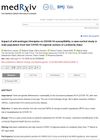Search
for
Sort by
Research
720-750 / 1000+ results
research The Effect of Topical RU58841 (Androgen Receptor Blocker) Combined with Minoxidil on Hair Growth in Macaque Androgenetic Alopecia
Combining RU58841 and minoxidil significantly increases hair growth.

research Experience in Treating Androgen-Dependent Diseases: Androgenetic Alopecia, Acne Agminata, Hirsutism with the Preparation Diane
The medicine Diane is effective in treating hair loss, severe acne, and excessive hair growth.
research The Selective Androgen Receptor Modulator GTx-024 (Enobosarm) Improves Lean Body Mass and Physical Function in Healthy Elderly Men and Postmenopausal Women: Results of a Double-Blind, Placebo-Controlled Phase II Trial
Enobosarm significantly increased muscle mass and improved physical function in elderly men and postmenopausal women without serious side effects.
research 3 Alpha, 17 Beta-Androstanediol Glucuronide in Plasma: A Marker of Androgen Action in Idiopathic Hirsutism
High levels of 3 alpha-diol glucuronide in the blood are a marker of increased androgen action in women with excessive hair growth of unknown cause.

research The Importance of Adequate Serum Ferritin Levels During Oral Cyproterone Acetate and Ethinyl Estradiol Treatment of Diffuse Androgen-Dependent Alopecia in Women
Having enough iron improves the effectiveness of a specific hair loss treatment in women.

research The Effects of Finasteride on Scalp Skin and Serum Androgen Levels in Men with Androgenetic Alopecia
Finasteride effectively reduces hair loss by decreasing androgen levels.
research Selective Androgen Receptor Modulators Negatively Regulate Triple-Negative Breast Cancer Growth and Epithelial-Mesenchymal Stem Cell Signaling
SARMs may be an effective treatment for a certain type of breast cancer by blocking cancer growth and spread.

research 46,XY DSD Due to Impaired Androgen Production
Impaired androgen production in 46,XY DSDs causes ambiguous genitalia and requires long-term care.

research A Novel Finasteride 0.25% Topical Solution for Androgenetic Alopecia: Pharmacokinetics and Effects on Plasma Androgen Levels in Healthy Male Volunteers
New finasteride solution effectively reduces baldness-causing hormone, potentially with fewer side effects.

research Prevalence of CYP21 Mutations and IRS1 Variant Among Women With Polycystic Ovary Syndrome and Adrenal Androgen Excess
Some women with PCOS have CYP21 mutations and IRS1 variants, but these genetic factors are not major contributors to PCOS.
research Nonsteroidal Tissue Selective Androgen Receptor Modulators: A Promising Class of Clinical Candidates
Selective androgen receptor modulators (SARMs) are a promising type of drug for various health conditions due to their targeted actions.

research Polycystic Ovary Syndrome Is Associated With Anogenital Distance, A Marker Of Prenatal Androgen Exposure
Women with polycystic ovary syndrome tend to have a longer anogenital distance.

research Plasma C19 Steroid Sulfate Levels and Indices of Androgen Bioavailability in Female Pattern Androgenic Alopecia
Women with female pattern hair loss have higher levels of certain androgens, suggesting increased androgen exposure to hair follicles.

research Controversies Regarding Transdermal Androgen Therapy in Postmenopausal Women
Testosterone therapy may slightly improve sexual function in postmenopausal women, but its long-term safety is unknown.

research Structure of Human Steroid 5α-Reductase 2 with the Anti-Androgen Drug Finasteride
Finasteride irreversibly affects human steroid 5α-reductase 2, providing insight into its catalytic mechanism and disease-related mutations.

research Baldness, Benign Prostate Hyperplasia, Prostate Cancer, and Androgen Levels
The study found no link between baldness patterns and androgen levels in men with benign prostate enlargement or prostate cancer.

research Unchanged Androgen-Binding Properties of Sex Hormone-Binding Globulin in Male Patients with Liver Cirrhosis
SHBG binding properties are unchanged in male liver cirrhosis patients.

research Anti-Androgen Treatments for Hirsutism and Acne in Women of Childbearing Age
For women with moderate to severe unwanted hair growth or acne, birth control pills are the first choice, with other medications like cyproterone, spironolactone, flutamide, or finasteride as alternatives, and permanent hair removal should be done with electrolysis or laser.

research A Variant of the Glucocorticoid Receptor Gene Is Not Associated with Adrenal Androgen Excess in Women with Polycystic Ovary Syndrome
The N363S gene variant does not cause higher adrenal androgen levels in women with polycystic ovary syndrome.

research Chapter 17: Selective Androgen Receptor Modulators (SARMs)
Selective Androgen Receptor Modulators (SARMs) are drugs that can control the effects of androgens in different tissues, potentially having fewer side effects and promising for treating various conditions.

research No Metabolic Impact of Surgical Normalization of Hyperandrogenism in Postmenopausal Women with Ovarian Androgen-Secreting Tumors
Surgery to lower high testosterone in postmenopausal women with certain ovarian tumors doesn't significantly affect their metabolism.

research Stereocontrolled Synthesis of All Eight Stereoisomers of the Putative Anti-Androgen Cyoctol
Scientists made all eight versions of a compound called cyoctol, but found it's not an anti-androgen and it fully breaks down in the skin.

research Guava Leaf Extract as Bioactive Substances for Anti-Androgen and Antioxidant Activities
Guava leaf extract may help treat hair loss and protect cells by blocking certain genes and fighting damaging molecules.

research The Value of the Free Androgen Index Depends on the Phenotype of Polycystic Ovary Syndrome: A Single-Centre Experience
The free androgen index varies among women with different types of PCOS.

research Anti-Androgen Treatment of Hirsute Women: A Study on Stress Responses
The treatment reduced hair growth and testosterone in women with excess hair and had some effects on stress responses.

research Impact of Anti-Androgen Therapies on COVID-19 Susceptibility: A Case-Control Study in Male Population from Two COVID-19 Regional Centers of Lombardy, Italy
Men taking 5-alpha reductase inhibitors for prostate issues may be less likely to experience severe COVID-19, but it doesn't prevent ICU admission or death.
research Effects of Orlistat on Serum Androgen Levels Among Iranian Obese Women With Polycystic Ovarian Syndrome
Orlistat helped reduce weight and testosterone in obese women with PCOS but did not significantly affect other androgens or cholesterol levels.

research Extraordinary Claims Without Extraordinary Evidence: Controversy on Anti-Androgen Therapy for COVID-19
The letter is skeptical about the effectiveness of anti-androgen therapy for COVID-19 and calls for strong evidence from clinical trials.

research Alopecia Due to High Androgen Index Contraceptives
Some birth control pills can cause hair loss, and switching to ones with less androgen should help.